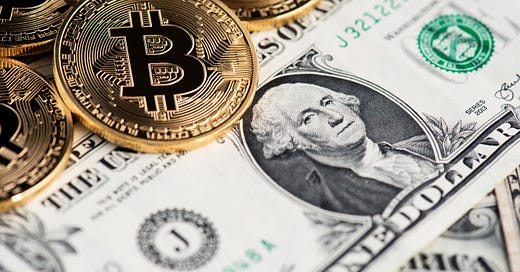Yes, The Fed Can Buy Bitcoin
Behind the pageantry and circus, the modern post-FOMC meeting press conference is a game with clearly delineated combatants and rules of engagement.
On the one side, we have the FOMC chair, currently occupied by Jerome Powell. Outwardly, his job is that of the morning disc jockey: to soothe people on their way to work, and assure the public that the weather in econo-land will be fine, just fine.
To optimally achieve this mission, the chair must reveal no more information than what’s contained in the FOMC’s written statement. Mr Powell’s delivery is truly excellent1 , hence his now familiar and reassuring sign-off: “We understand that our actions affect communities, families, and businesses across the country. Everything we do is in service to our public mission…”
On the other side is the individual journalist, presumably hand-picked from the nation's leading financial news organizations. Their job is that of the shock-jock, i.e. to get their main-stream guest to say something bat guano insane. In this case that means asking a question that rattles the FOMC chair out of his carefully choreographed hedging and extracts a material statement that moves markets.
On December 18th 2024 Neil Irwin of Axios scored a direct hit, asking:
”So if I may, speaking of assets that have been buoyant, do you see any value or benefit in the U.S. Government building a reserve of bitcoin?”
To which Jerome Powell flatly stated:
”So, we're not allowed to own bitcoin. The Federal Reserve Act says what we can own and we're not looking for a law change. That's the kind of thing for Congress to consider, but we are not looking for a law change at the Fed.”
This statement seemed immediately contradictory to the creation of a Strategic Bitcoin Reserve as suggested by President-elect Trump, as proposed in a Bill to implement the SBR by Senator Lummis, and as supported by numerous officials on both sides of the aisle. If the Federal government acquires BTC at scale for the purpose of reducing the national debt, it would be inevitable that BTC in some form would end up on the asset side of the Federal Reserve’s balance sheet.
Could the Fed, ostensibly not a partisan institution, block the Federal government from creating the SBR? The statements emanating from the FOMC chair are powerful; so called jaw-boning has been a weapon wielded by central bankers to bludgeon markets into submission from time immemorial2. However, as long as the SBR is structured modularly the Federal Reserve Act need not be touched at all.
What do I mean by modular? In particular, the choice of mechanism by which the Treasury uses BTC to pay back debt is imperative to the legal and financial integration of the SBR within the extant Federal Reserve System. In our view, the Bitcoin Act, which establishes the SBR, should grant the Treasury authority to issue a new currency backed directly by BTC to repay existing debt securities by issuing Bitcoin Dollar Certificates (BDCs).
Much like the redeemable certificates which existed under the gold standard, BDCs would be convertible on demand into their face value into one dollar worth of BTC3. BDC’s would technically be obligations of the US Treasury, which the Fed is already authorized to purchase in the Federal Reserve Act. Since the Federal Reserve is one of the largest holders of Treasury securities, BDCs will end up on the Fed’s balance sheet, resulting in the full monetization of the backing BTC and the birth of a nascent Bitcoin Standard.
BDCs possess other desirable qualities as compared to other alternatives. Repayment of existing debt securities with BDCs would not drain bank reserves and thus preserve bank liquidity. This is critical during a time of shrinking reserves due to QT. Additionally, issuing BDCs would avoid the negative price impact of direct sales of BTC on the open market and would remove the possibility of private sector front running. Furthermore, by construction BDCs provide a free call option on BTC to the SBR4 as well as maximize the size of BTC within the SBR5.
While this discussion might seem like a minor technicality, I assure you that the introduction of BDCs is a game changer in terms of rebalancing the power between the Federal Government and the Federal Reserve. BDCs could be used to fund innovation and preserve the role of the US dollar as the world reserve currency, potentially breaking the current cycle of baseless money printing which underpins our fragile system where QT is fleeting but QE is forever.
BDCs restore the ancient ability of the government to issue money directly backed by a commodity without relying on the Federal Reserve to print bank reserves to monetize government debt. BDCs are in many ways a leap forward, and in other ways a return to what was, and has been taken from Americans.
I invite you to watch an FOMC press conference if you have not already. It’s literally like the scene in Trading Places where the trading floor stops and waits for the crop report to be delivered. Except that the “crops” in question are every asset on the planet earth and the scene is real.
See the famous example of Mario Draghi in July 2012: “the ECB is ready to do whatever it takes… And believe me, it will be enough.”
As determined by an agreed upon mark-to-market price oracle.
BDCs pay back debt without the BTC leaving the SBR, thus retaining the potential upside for the Treasury should BTC appreciate further. Should the price of BTC decline, the Treasury would have the option of retiring BDCs with normal USD, e.g. from taxes or securities auctions, giving the Government maximum flexibility in managing its liabilities.
Only holders with ability to self-custody (or retain an institutional custodian) will possibly want to redeem BDCs for physical BTC, which will result in the SBR retaining more BTC over time than other repayment methods.






